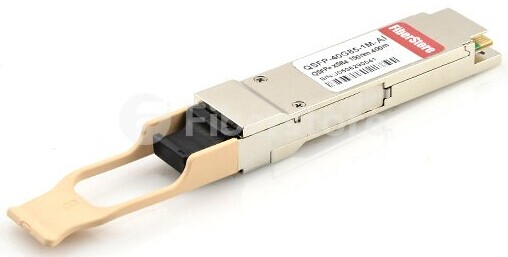Overview
The 40-Gigabit QSFP+ transceiver module is a hot-swappable, parallel fiber-optical module with four independent optical transmit and receive channels. These channels can terminate in another 40-Gigabit QSFP+ transceiver, or the channels can be broken out to four separate 10-Gigabit SFP+ transceivers. The QSFP+ transceiver module connects the electrical circuitry of the system with either a copper or an optical external network. The transceiver is used primarily in short reach applications in switches, routers, and data center equipment where it provides higher density than SFP+ modules.
Installing a QSFP+ Transceiver
The QSFP+ transceiver module can have either a bail-clasp latch or a pull-tab latch. Installation procedures for both types of latches are provided.
To install an QSFP+ transceiver module, follow these steps:
Step 1 Attach an ESD wrist strap to yourself and a properly grounded point on the chassis or the rack.
Step 2 Remove the QSFP+ transceiver module from its protective packaging.
Step 3 Check the label on the QSFP+ transceiver module body to verify that you have the correct model for your network.
Step 4 For optical QSFP+ transceivers, remove the optical bore dust plug and set it aside.
Step 5 For transceivers equipped with a bail-clasp latch:
a. Keep the bail-clasp aligned in a vertical position.
b. Align the QSFP+ transceiver in front of the module's transceiver socket opening and carefully slide the QSFP+ transceiver into the socket until the transceiver makes contact with the socket electrical connector. (See Figure1)
Step 1 Attach an ESD wrist strap to yourself and a properly grounded point on the chassis or the rack.
Step 2 Remove the QSFP+ transceiver module from its protective packaging.
Step 3 Check the label on the QSFP+ transceiver module body to verify that you have the correct model for your network.
Step 4 For optical QSFP+ transceivers, remove the optical bore dust plug and set it aside.
Step 5 For transceivers equipped with a bail-clasp latch:
a. Keep the bail-clasp aligned in a vertical position.
b. Align the QSFP+ transceiver in front of the module's transceiver socket opening and carefully slide the QSFP+ transceiver into the socket until the transceiver makes contact with the socket electrical connector. (See Figure1)

Step 6 For QSFP+ transceivers equipped with a pull-tab:
a. Hold the transceiver so that the identifier label is on the top.
b. Align the QSFP+ transceiver in front of the module's transceiver socket opening and carefully slide the QSFP+ transceiver into the socket until the transceiver makes contact with the socket electrical connector.
Step 7 Press firmly on the front of the QSFP+ transceiver with your thumb to fully seat the transceiver in the module's transceiver socket. (See Figure2)
a. Hold the transceiver so that the identifier label is on the top.
b. Align the QSFP+ transceiver in front of the module's transceiver socket opening and carefully slide the QSFP+ transceiver into the socket until the transceiver makes contact with the socket electrical connector.
Step 7 Press firmly on the front of the QSFP+ transceiver with your thumb to fully seat the transceiver in the module's transceiver socket. (See Figure2)

Step 8 For optical QSFP+ modules, reinstall the dust plug into the QSFP+ transceivers optical bore until you are ready to attach the network interface cable. Do not remove the dust plug until you are ready to attach the network interface cable.
Removing a QSFP+ Transceiver
To remove a QSFP+ transceiver, follow these steps:
Step 1 For optical QSFP+ transceivers, disconnect the network interface cable from the QSFP+ transceiver connector.
Step 2 For QSFP+ transceivers equipped with a bail-clasp latch (See Figure3, top view):
a. Pivot the bail-clasp down to the horizontal position.
b. Immediately install the dust plug into the transceivers optical bore.
c. Grasp the sides of the QSFP+ transceiver and slide it out of the module socket.
Step 1 For optical QSFP+ transceivers, disconnect the network interface cable from the QSFP+ transceiver connector.
Step 2 For QSFP+ transceivers equipped with a bail-clasp latch (See Figure3, top view):
a. Pivot the bail-clasp down to the horizontal position.
b. Immediately install the dust plug into the transceivers optical bore.
c. Grasp the sides of the QSFP+ transceiver and slide it out of the module socket.

Step 3 For QSFP+ transceivers equipped with a pull tab latch (See Figure3, bottom view):
a. Immediately install the dust plug into the transceiver's optical bore.
b. Grasp the tab and gently pull to release the transceiver from the socket.
c. Slide the transceiver out of the socket.
Step 4 Place the QSFP+ transceiver into an antistatic bag.
a. Immediately install the dust plug into the transceiver's optical bore.
b. Grasp the tab and gently pull to release the transceiver from the socket.
c. Slide the transceiver out of the socket.
Step 4 Place the QSFP+ transceiver into an antistatic bag.
Conclusion
As 40 GbE are widely deployed, 40G transceiver optics are ubiquitous. A good practice and correct installation are very important for 40G network system, not only to protect the 40G transceiver optics and device from damage, but also to ensure a stable performance of the system. Fiberstore offers a wide range of 40G transceiver modules, such as QSFP-40G-LR4-S, QSFP-40G-SR4-S, QSFP-40G-ER4, etc. All these transceivers are tested in the original-brand switches to guarantee the high compatibility with major brands. For more information or quotation, please contact us via sales@fs.com.

No comments:
Post a Comment